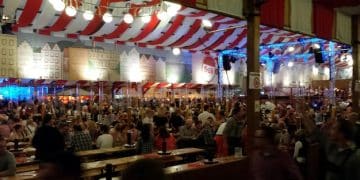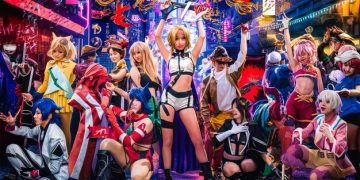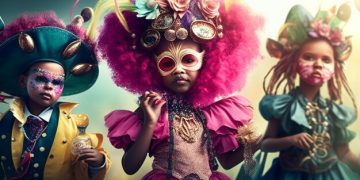Cosplay: More Than Just a Costume – A Deep Dive
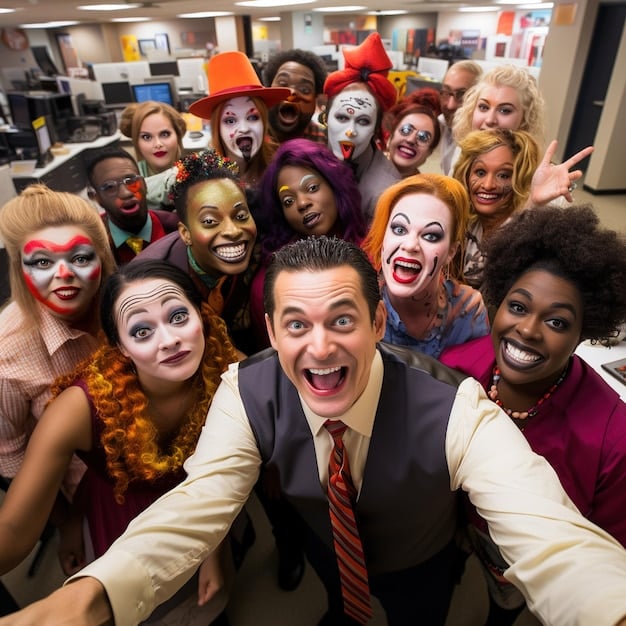
Cosplay, short for “costume play,” is a vibrant subculture where participants create and wear outfits to embody specific characters, often from anime, manga, video games, and comic books, extending far beyond simple costume parties into a passionate form of artistic expression and community engagement.
Dive into the colorful world of cosplay, where creativity meets fandom and self-expression takes center stage.Cosplay is much more than just wearing a costume; it’s an immersive experience that combines artistry, performance, and a deep love for pop culture.
What is Cosplay? Unveiling the Basics
At its heart, cosplay is about bringing fictional characters to life. But what exactly does it entail? This section breaks down the fundamental aspects of cosplay.
From selecting the right character to crafting the perfect outfit, understanding the core elements is the first step into this exciting hobby.
Defining Cosplay
Cosplay, derived from “costume play,” involves dressing up as characters from various media. This can include anime, manga, video games, comic books, movies, and even original characters. The goal is to embody the character through costume, makeup, and even performance.
The Key Components of Cosplay
Successful cosplay involves more than just putting on a costume. It requires attention to detail, creativity, and a genuine connection to the character. Here are some essential components:
- Costume Design: Crafting or sourcing the outfit, often involving sewing, armor-making, and prop creation.
- Character Interpretation: Understanding the character’s personality, mannerisms, and backstory to accurately portray them.
- Presentation: The overall look and feel, including makeup, wigs, and accessories.
- Performance: Bringing the character to life through poses, expressions, and interactions with others.
Cosplay combines various skills and passions, making it a versatile and rewarding hobby for those who enjoy both crafting and performance.
Understanding these basics can help newcomers appreciate the artistry and dedication that goes into creating stunning and accurate cosplays.
The History and Evolution of Cosplay
Cosplay has a rich history that spans decades and continents. Tracing its origins and understanding its evolution provides insight into how it has become the global phenomenon it is today.
From its humble beginnings to its current mainstream popularity, the journey of cosplay is a testament to the enduring power of fandom and creativity.
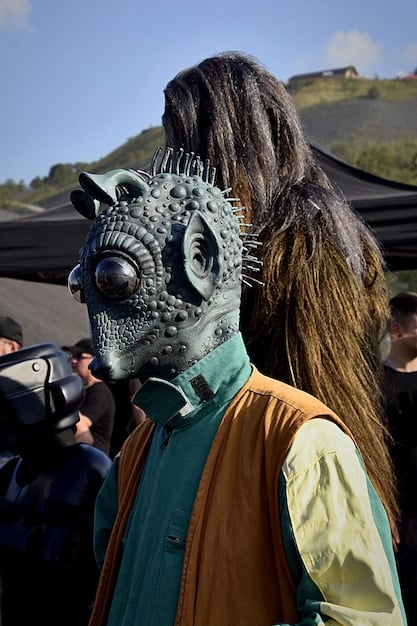
Early Origins
The roots of cosplay can be traced back to the early 20th century, with fan-made costumes appearing at science fiction conventions. One of the earliest documented instances was at the 1939 World Science Fiction Convention in New York, where attendees dressed in futuristic costumes.
Japanese Influence
Cosplay truly began to take shape in Japan during the 1970s. Comic Market (Comiket), a semi-annual event for self-published manga, provided a platform for fans to showcase their elaborate costumes. The term “cosplay” itself was coined by Nobuyuki Takahashi in 1984 after attending a science fiction convention in Los Angeles.
Global Expansion
In the 1990s and 2000s, cosplay spread globally, fueled by the growing popularity of anime and video games. Internet forums and social media platforms allowed cosplayers from around the world to connect, share tips, and showcase their creations. Conventions like Comic-Con International in San Diego became major hubs for cosplay.
The evolution of cosplay reflects the changing landscape of fandom and the increasing accessibility of resources and materials for costume creation.
From niche hobby to mainstream phenomenon, cosplay’s journey has been marked by creativity, community, and a shared love for pop culture.
The Art and Craft of Cosplay
Cosplay is a multifaceted art form that combines various crafting skills. Exploring the techniques and materials involved provides a deeper appreciation for the dedication of cosplayers.
From sewing and embroidery to 3D printing and prop making, the artistry behind cosplay is both diverse and impressive.
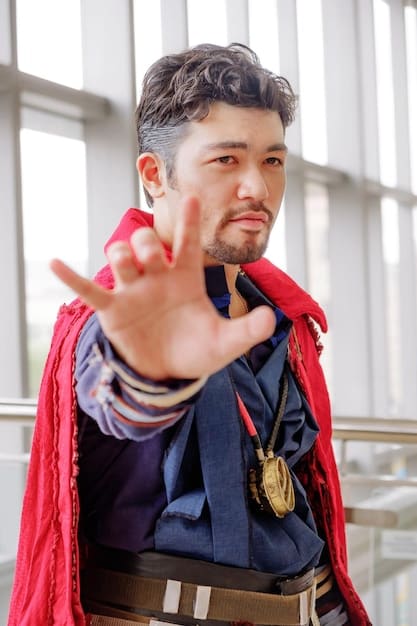
Costume Construction
Creating a cosplay costume often involves a combination of sewing, pattern making, and fabric manipulation. Cosplayers may spend hours researching designs, drafting patterns, and meticulously stitching together garments. Attention to detail and accuracy are key.
Prop Creation
Many cosplay characters wield weapons or carry unique accessories. Prop creation can involve a variety of materials and techniques, including foam crafting, woodworking, 3D printing, and resin casting. Safety is also a primary concern, especially when creating weapon replicas.
Makeup and Wigs
The right makeup and wig can completely transform a cosplayer’s appearance. Makeup techniques can be used to replicate a character’s facial features, while custom-styled wigs can capture the character’s unique hairstyle. These elements are essential for completing the overall look.
- EVA Foam: A versatile material used for creating lightweight and durable armor pieces.
- Worbla: A thermoplastic that can be molded and shaped when heated, ideal for creating intricate details.
- 3D Printing: Used to create complex shapes and designs that would be difficult to achieve through traditional methods.
Mastering these skills requires practice, patience, and a willingness to experiment. The end result is a stunning transformation that pays homage to the character. The creative process from concept to completion is a rewarding journey for any aspiring cosplayer.
The Community and Culture of Cosplay
Cosplay is more than just an individual hobby; it’s a vibrant community built on shared interests and mutual support. Exploring the social aspects of cosplay reveals the friendships and connections that make it so meaningful.
From conventions and meetups to online forums and groups, the cosplay community is a welcoming and inclusive space for fans of all backgrounds.
Conventions and Events
Conventions are the heart of the cosplay community. Events like Comic-Con, Anime Expo, and Dragon Con provide opportunities for cosplayers to showcase their creations, meet fellow fans, and participate in contests and panels. These gatherings foster a sense of camaraderie and celebration.
Online Communities
Social media platforms, forums, and online groups play a vital role in connecting cosplayers from around the world. These virtual spaces allow cosplayers to share their work, ask for advice, and collaborate on projects. Online communities break down geographical barriers and create a global network of support.
Cosplay Etiquette
Within the cosplay community, certain etiquette guidelines are followed to ensure a positive and respectful environment. These include asking permission before taking photos, respecting personal space, and being mindful of costume sizes and mobility. Adhering to these guidelines helps maintain a welcoming and inclusive atmosphere.
The relationships forged through cosplay often extend beyond the hobby, forming lasting friendships and professional connections.
Whether at a convention or online, the cosplay community is a supportive and inspiring place for fans to express their creativity and connect with others who share their passion.
Cosplay and Self-Expression
Cosplay provides a unique outlet for self-expression and personal growth. Exploring how cosplay empowers individuals to embrace their identities and overcome challenges highlights its profound impact.
From building confidence to exploring different facets of their personality, cosplay offers a transformative experience for many participants.
Embracing Identity
Cosplay allows individuals to explore and express their identities in a safe and creative environment. By embodying characters they admire or identify with, cosplayers can connect with different aspects of themselves and gain a deeper understanding of who they are.
Building Confidence
The process of creating and wearing a cosplay can be incredibly empowering. From mastering new skills to overcoming challenges, cosplayers build confidence and self-esteem. The positive feedback and support from the community further reinforce this sense of accomplishment.
Overcoming Challenges
Cosplay can also be a means of overcoming personal challenges. Some cosplayers use it as a form of therapy, while others use it to challenge societal norms and expectations. The act of transforming into a character can be liberating and transformative.
- Therapeutic Outlet: Engaging in cosplay can provide a creative and therapeutic outlet for dealing with stress, anxiety, or other mental health challenges.
- Social Empowerment: Cosplay can empower individuals to connect with others, build social skills, and overcome feelings of isolation.
- Creative Expression: The act of creating and performing a cosplay allows individuals to express their creativity and artistic talents in a unique and meaningful way.
The transformative power of cosplay extends beyond the costume, shaping the lives of those who participate.
By embracing their passions and connecting with others, cosplayers find joy, fulfillment, and a sense of belonging in the cosplay community.
The Future of Cosplay
As technology advances and fandom continues to grow, the future of cosplay is full of exciting possibilities. Exploring emerging trends and innovative techniques provides a glimpse into what lies ahead.
From virtual cosplay to sustainable materials, the evolution of cosplay is driven by creativity, innovation, and a commitment to inclusivity.
Technological Advancements
Advances in 3D printing, virtual reality, and augmented reality are opening up new possibilities for cosplay. Cosplayers can now create intricate props and accessories with greater ease and precision. Virtual cosplay allows fans to embody characters in digital spaces, while augmented reality can enhance real-world costumes with interactive elements.
Sustainability and Ethical Practices
As environmental concerns grow, cosplayers are increasingly adopting sustainable and ethical practices. This includes using recycled materials, supporting fair labor practices, and reducing waste. Cosplayers are also becoming more conscious of cultural appropriation and promoting inclusivity within the community.
Expanding Horizons
Cosplay is expanding beyond traditional conventions and events. Online platforms and virtual communities are providing new avenues for cosplayers to showcase their talents and connect with fans. Cosplay is also becoming more integrated into mainstream media, with cosplayers appearing in commercials, movies, and television shows.
The growth and evolution of cosplay reflect the ever-changing landscape of fandom and technology.
By embracing innovation, promoting sustainability, and fostering inclusivity, the cosplay community is ensuring a vibrant and dynamic future for this beloved art form.
| Key Aspect | Brief Description |
|---|---|
| 🎭 Definition | Cosplay is dressing up as characters, emphasizing costume and performance. |
| 🧵 Crafting | Involves sewing, prop making, and makeup artistry. |
| 🤝 Community | A social network connecting people with common interests. |
| 🚀 Future | Innovations in technology and sustainable practices. |
FAQ About Cosplay
▼
Common materials include fabrics like cotton, silk, and synthetics, as well as EVA foam for armor, Worbla for shaping, and 3D-printed components for intricate designs. Cosplayers choose materials based on the character’s outfit and durability needs.
▼
Pick a character you love and feel connected to! Consider your skill level and budget. Start with simpler costumes and gradually take on more complex designs as you gain experience. The key is to have fun and enjoy bringing your favorite character to life.
▼
Study your character’s iconic poses and practice them in front of a mirror. Pay attention to your posture and facial expressions. Engage with your surroundings and interact with other cosplayers. Most importantly, have fun and let your personality shine through!
▼
Cosplay enhances self-esteem by providing a creative outlet, skill development, and community participation. Successfully embodying a character and receiving positive feedback boosts confidence. This fosters a sense of accomplishment and personal growth through shared experiences.
▼
Yes, many conventions host cosplay competitions where participants are judged on craftsmanship, accuracy, and performance. Awards range from recognition to prizes. These competitions are a great way for cosplayers to showcase their talents and gain recognition from the community.
Conclusion
Cosplay represents much more than mere costumes; it is a vibrant community, an expressive art, and a journey of personal growth. From humble origins to global phenomenon, cosplay’s impact on geek culture is undeniable. As technology and creativity continue to advance, the future of cosplay promises even more exciting and innovative ways for fans to connect, create, and celebrate the characters they love.
